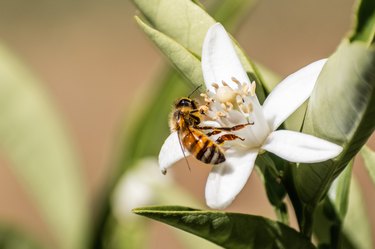
Controlling carpenter bees can be challenging, and if left to their own devices, these destructive pests can cause extensive and expensive property damage. A carpenter bee hole size is about half an inch. If you notice a bunch of holes with accompanying little piles of sawdust on the deck or drilled into other wood on your property, you could have a carpenter bee hive nearby.
Can You Plug a Carpenter Bee Hole?
Video of the Day
To begin your campaign against a carpenter bee invasion, start by locating any abandoned holes. They won't go after humans unless touched or provoked, so step away for your own safety if you see any of these bees near a hole. You can plug these holes after finding them, but you must treat them first. Can carpenter bees eat through caulk? They can eat through caulking compounds, so just covering the holes with this won't solve your problem.
Video of the Day
If you don't treat the holes before you repair them, the bees will return to them. You can fill carpenter bee holes with spray foam products made for this purpose. These are made by brands like Spectracide, AMDRO and BioAdvanced. Spray the product right into the holes. Then, you can fill the holes with a bit of aluminum foil or steel wool treated with more of the insecticide.
What About Active Carpenter Bee Holes?
Active carpenter bee holes can also be treated with a targeted dose of insecticide as long as you don't see busy bees in or near them. The best spray for carpenter bees will have carbaryl (Sevin), boric acid or pyrethrum in their ingredient list. Look for ones labeled for flying insects, and you should be able to find what you need. The optimum time for treating the holes is at night, as that's when these bees are usually resting. You can also treat the tunnels in early spring while the bees are still hibernating.
These insecticides come in spray and powder form. Apply it right inside the holes upwind to avoid getting any on yourself. Also, be on guard in case one flies out toward you. Give it 24 hours to work; you can repair the hole the next day. You can fill it with a small piece of wood and wood glue and then paint over it to camouflage the repair.
Dealing With Carpenter Bees
Carpenter bees are often mistaken for bumblebees, but they have shiny, bluish-black abdomens instead of hairy yellow ones. Carpenter bees also fly in diving, darting patterns, while bumblebees are prone to flying in straight lines. They're most active in the spring and are drawn to the exposed wood. Once the eggs hatch, the young bees leave the tunnel to feed on pollen in the general area but sometimes return to clean out their nest.
The insecticide sprays and powders are effective but don't last forever. It's best to plug the holes afterward with foil or steel wool to reduce the chance of any future nesting activity. Still, if there is a large carpenter bee nest in the vicinity and the problem is out of control, the best bet will be to call an exterminator. There's also the option of switching out your wood for composite materials, like vinyl siding and masonry.